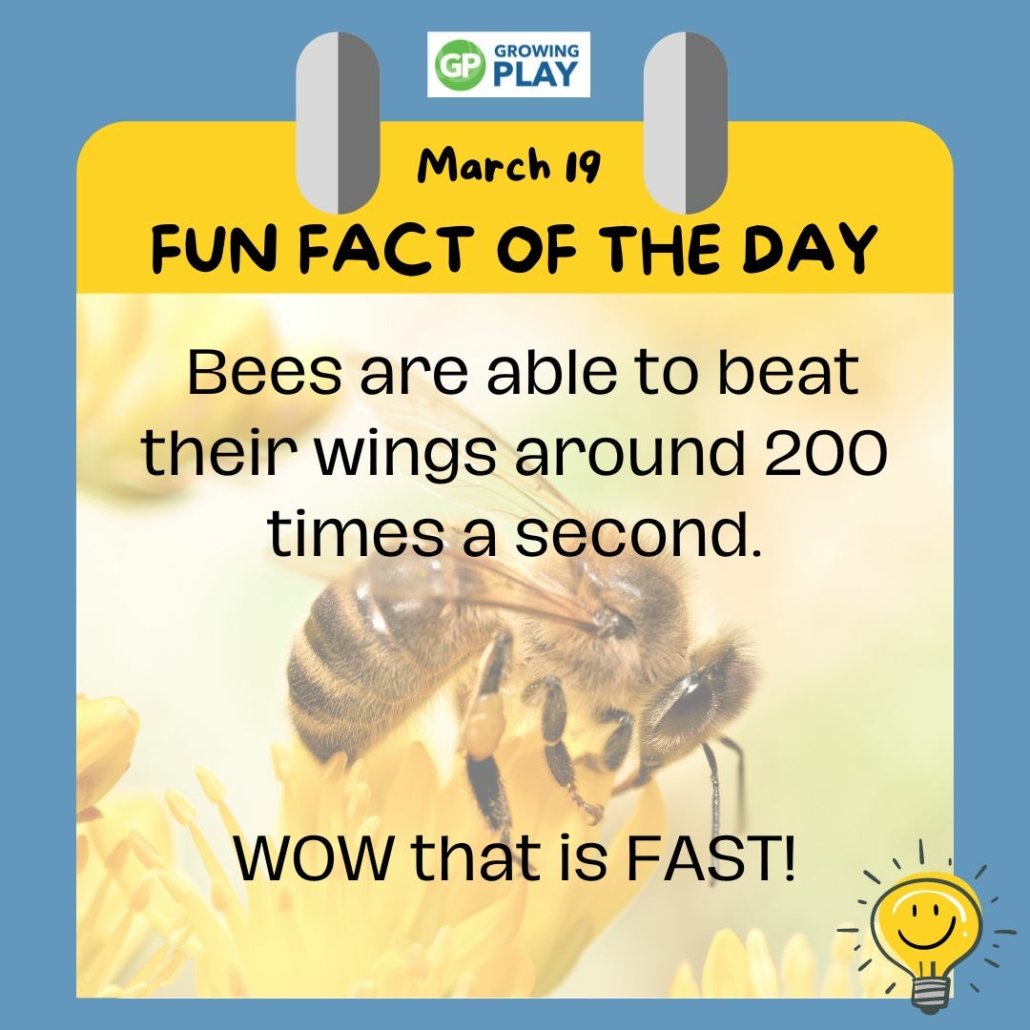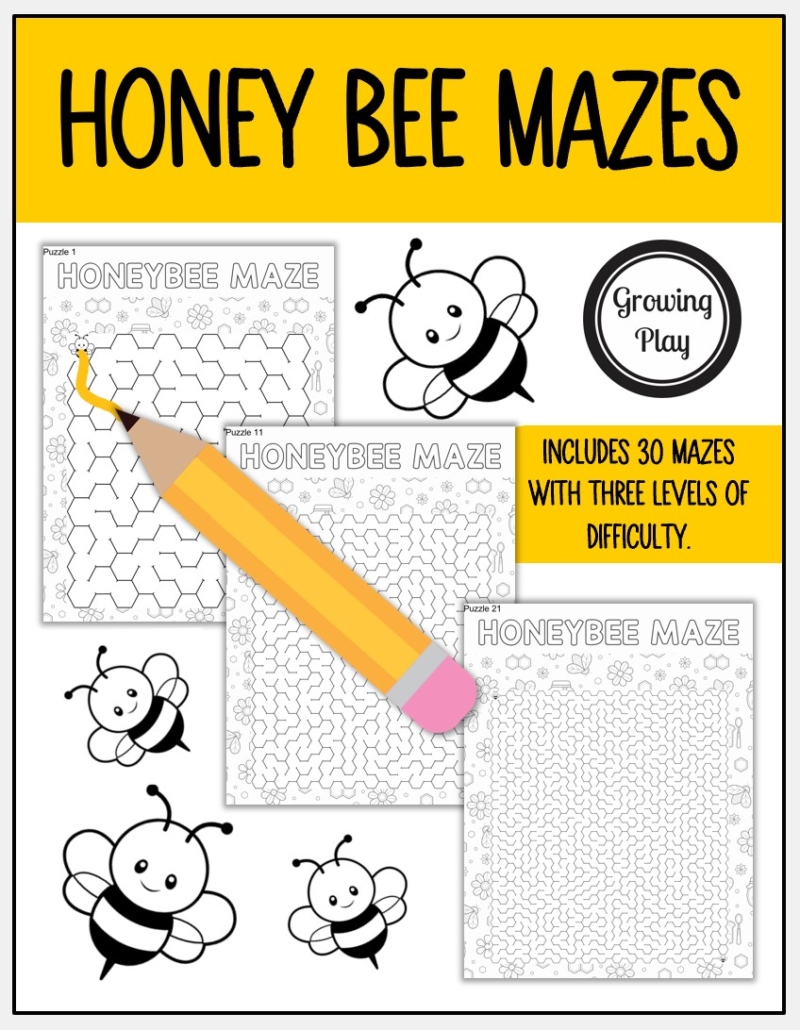March 19 – Bee Facts for Kids

Today, March 19, let’s buzz into the fascinating world of bees with these fun bee facts for kids! These tiny, buzzing creatures are not only vital for our ecosystem but are also incredibly interesting. From their unique communication methods to their important role in pollination, there’s so much to learn about bees. And remember, you can check out all of the Fact of the Day for Kids here.
20 FUN BEE FACTS FOR KIDS
Let’s learn interesting facts about members of the bee hive! Read these 20 facts about the wonderful world of bees.
- Bees Have Five Eyes: Bees are equipped with five eyes – two large ones on their sides for seeing patterns and colors, and three smaller ones on top of their head for detecting light intensity.
- A Bee’s Rapid Wing Beat: A bee’s wings flutter about 200 times per second, which is what creates their buzzing sound.
- Bees: Nature’s Chefs: Bees are the only insects in the world that produce food (honey) that humans can eat.
- The Waggle Dance: Honeybees perform a unique dance called the “waggle dance” to share information on the location of food sources with their hive mates.
- Diverse Bee Species: There are over 20,000 different species of bees around the globe making up the bee population. Each adult bee with its own unique characteristics and role in the ecosystem.
- The Queen’s Impressive Productivity: A queen bee can lay up to 2,500 eggs in a single day during her peak season, showcasing her crucial role in the hive’s survival.
- All-Female Workforce: Worker bees, responsible for all the tasks needed to maintain and protect the hive, are all female.
- Bees’ Flight Equipment: Bees have two pairs of wings, with the rear wings being smaller than the front ones, which they hook together when flying.
- Bee’s Honey Contribution: The average bee makes only 1/12th of a teaspoon of honey over its entire lifetime, highlighting the collective effort needed to produce honey.
- Pollen Baskets: Bees have special structures called pollen baskets on their hind legs, which they use to collect and carry pollen back to their hive.
- Carpenter Bees’ Solo Life: Carpenter bees create individual nests in wood rather than living in colonies, showcasing a unique lifestyle among bees.
- Royal Jelly’s Power: This special substance is what turns a bee larvae into a queen bee, thanks to its miraculous nutritional profile.
- Bee Communication: Through their sophisticated waggle dance, bees can tell their hive mates precisely where to find the best food sources.
- Friendliness of Stingless Bees: In the world of bees, there are species known as stingless bees, which are harmless to humans and play a vital role in pollination.
- Bees in Winter: During the winter months, bees focus on keeping the queen warm and prepare for the upcoming spring, proving their hard work doesn’t stop with the cold.
- Bees’ Vision: With their large eyes, bees have an incredible vision that helps them in finding flowers and navigating their environment.
- The Sacrifice of a Bee Sting: A bee’s sting is a defensive act that ultimately costs the bee its life, emphasizing their dedication to hive protection.
- The Effort Behind Honey: It requires the collective effort of many bees, visiting millions of flowers, to produce just one pound of honey.
- The Hive’s Social Order: Every bee in the hive has a designated role, from nurturing the young to defending the hive, ensuring the colony’s efficiency and survival.
- World of Bees: With over 20,000 kinds of bees, our world is filled with a diverse range of these fascinating insects, each contributing uniquely to their ecosystems.

Bee Maze Packet
ACTIVITY IDEAS TO CELEBRATE BEES
Let’s make our classrooms and schools buzz with activities celebrating bees! Here are some fun and educational ways to learn more about these essential creatures:
- Finish the Bee Word Search
- Create bee-themed art using hexagonal shapes to mimic honeycombs.
- Plant bee-friendly flowers in the school garden to attract and support local bee populations.
- Hold a “Bee Facts” quiz based on today’s fun facts.
- Craft bee antennae headbands for a bee-themed dress-up day.
- Write and perform a short play about the life cycle of a bee.
QUESTIONS TO THINK ABOUT BEE FACTS
Ponder these questions to dive deeper into the world of bees and their importance:
- Why is the waggle dance an effective way for bees to communicate?
- How do bees affect the food chain and our food supply?
- What would happen if there were no bees?
- Why do bees collect pollen, and how do they use it?
- How do different types of bees contribute to the environment?
WOULD YOU RATHER QUESTIONS ABOUT BEES
Here are five questions to spark conversation. Would you rather…
- …be a worker bee or a queen bee for a day?
- …eat honey every day for a month or never eat it again?
- …have the ability to communicate like bees do with a waggle dance or through traditional human speech?
- …have a garden that attracts bees or butterflies?
- …wear a bee costume for a day or plant a flower garden for bees?
MORE FUN STUFF
Here are more fun ideas to help keep the kids entertained:
- Fun Facts for Kids
- Honey Bee Facts for Kids
- Find Bees Visual Discrimination Activity
- Bee Maze Packet
It’s clear that these remarkable insects play an essential role in our ecosystem. From the diligent female worker bees to the fertile queen bee, each member of the hive has a special job that contributes to the survival of their colony and the production of sweet honey. Bees, particularly the European honey bee and various native species across North America, are not only important pollinators of flowering plants but also a critical link in the balance of our environment. Despite challenges like colony collapse disorder and the threat to their populations, bees continue to fascinate us with their complex societies, incredible work ethic, and the delicious honey they produce. It’s important for us, as bee lovers and stewards of our planet, to support local beekeepers, plant bee-friendly flowers, and learn more about these social insects. By understanding the vital role bees play and the amazing facts about their lives, we can appreciate the sweet rewards of their hard work every time we enjoy a tablespoon of honey. Let’s continue to explore and protect the amazing world of bees, ensuring these important pollinators thrive for generations to come.


